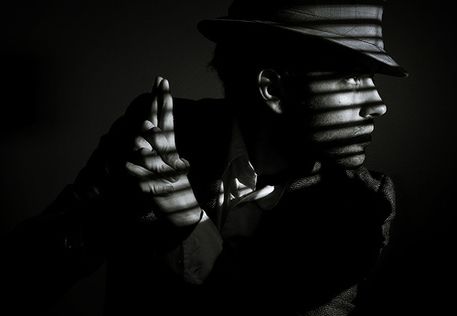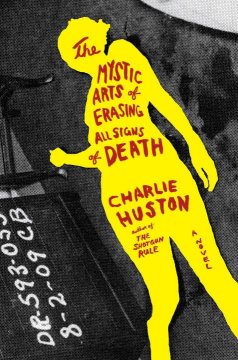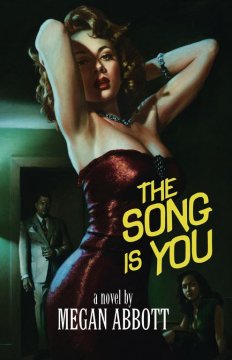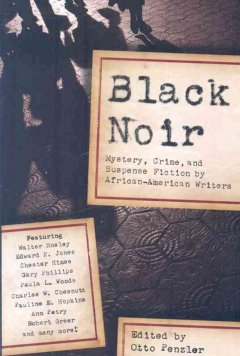 I’ve said it before–I love noir fiction.
I’ve said it before–I love noir fiction.
 I love everything about it–from the original hard-boiled, cynical detective novels, like Sam Spade, to the films of dim, foggy streets, shadows, and moral conundrums, like The Maltese Falcon. Part of it, I think, is because I am an intensely wordy person (which, I am sure, comes as no surprise here), and the fact that noir fiction, traditionally, manages to cram so much meaning, emotion, and significance into the shortest of sentences is a marvel to me. I also love the traditional noir hero (and the occasionally heroine, too!) whose heart is usually made of solid gold, but who has been so beaten down by the heartlessness of the world that they end up standing outside it–and, often against it. There’s a reason why noir protagonists are private detectives, assassins, vampires (no, seriously), and generally loners–there is no place for them in the world, so they have to stand outside it and find a way to challenge it alone. And while I enjoy the mysteries that make up the plot of many noir novels, I love the deeply personal character development that comes from the character’s almost mythical quest to take on all the darkness of the world around them.
I love everything about it–from the original hard-boiled, cynical detective novels, like Sam Spade, to the films of dim, foggy streets, shadows, and moral conundrums, like The Maltese Falcon. Part of it, I think, is because I am an intensely wordy person (which, I am sure, comes as no surprise here), and the fact that noir fiction, traditionally, manages to cram so much meaning, emotion, and significance into the shortest of sentences is a marvel to me. I also love the traditional noir hero (and the occasionally heroine, too!) whose heart is usually made of solid gold, but who has been so beaten down by the heartlessness of the world that they end up standing outside it–and, often against it. There’s a reason why noir protagonists are private detectives, assassins, vampires (no, seriously), and generally loners–there is no place for them in the world, so they have to stand outside it and find a way to challenge it alone. And while I enjoy the mysteries that make up the plot of many noir novels, I love the deeply personal character development that comes from the character’s almost mythical quest to take on all the darkness of the world around them.
So when I saw this article published in Electric Literature, titled “Noir Is Protest Literature: That’s Why It’s Having a Renaissance” I was thrilled. It’s absolutely true that noir fiction is having a renaissance–from True Detective and Breaking Bad to popular authors like Charlie Huston, Denies Mina, and Adrian McKinty…but I never really thought about why.
Nicholas Seeley does a magnificent job pointing out that noir fiction has always been a form of protest, first and foremost against the traditional Anglo-American crime novel where a detective of some sort restores order to society that has been disrupted by a crime, and isolates and excises the evil from society. But, especially in the years after the Second World War, the idea that evil could be expunged seemed ludicrous, and noir fiction directly confronts this.
Noir stories gave the stage to criminals and their motivations, which range from unspeakable passions to a firm conviction that their particular crime serves a greater good. A detective may pursue such a criminal, but noir reveals the line between them to be a product of chance and circumstance—if, indeed, such a line exists at all.
 But even as noir rejected ideas of the world as it “should be” in favor of the world as it really was, it still remained the domains of very traditional heroes. As Seeley notes, “Classic noir presented worlds of corruption and inequality, but it was still primarily inequality between white men. Women remained cutouts…Racial and sexual minorities fared even worse: they were cast mostly as set dressing, or as villains, tempting innocent white people into depravity.”
But even as noir rejected ideas of the world as it “should be” in favor of the world as it really was, it still remained the domains of very traditional heroes. As Seeley notes, “Classic noir presented worlds of corruption and inequality, but it was still primarily inequality between white men. Women remained cutouts…Racial and sexual minorities fared even worse: they were cast mostly as set dressing, or as villains, tempting innocent white people into depravity.”
Thankfully, admitting you have a problem is the first step to solving it, and, with the resurgence of noir, there is the potential for making it the truly subversive, defiant genre that it can be, taking on not just issues of white-bred corruption, but themes of race, sex, gender, and class identities. Once again, to quote Seeley:
Light can slant harshly though Venetian blinds in most any neighborhood on the planet; tough-as-nails private investigators can come in any gender identity or color of the rainbow; doom-driven crooks can ride from first kiss to gas chamber with a member of the same sex as easily as the opposite.
So, in honor of this fantastic article, which you should definitely read in its entirety, and in honor of the wonderfulness that is the noir genre as a whole, that I’d offer you a few atypical noir novels to get you started down your dimly-lit and dangerous path into the world of noir fiction…
 The Mystic Art of Erasing All Signs of Death: Charlie Huston, as I mentioned above, is a stupendous noir author, who brought the genre into the realm of the paranormal, as well as into the world of blue-collar works. In this book, habitual slacker Webster Fillmore Goodhue finds his teaching career destroyed by tragedy and, without any other options, joins the Clean Team, a company assigned to clean up some of L.A.’s grisliest crime scenes. But when a dead man’s daughter asks for his help, Web finds himself in the middle of a war between urban cowboys and rival cleaning teams that forces him to make the first–and perhaps the most significant–choices of his life. Huston was actually my first real entrance into noir, but he remains one of my favorite because he’s just so good: he conveys the voices of his diverse and varied cast with pitch-perfect accuracy, and brings the seedy, grim world they inhabit to life so vividly that you really want to wash your hands while reading.
The Mystic Art of Erasing All Signs of Death: Charlie Huston, as I mentioned above, is a stupendous noir author, who brought the genre into the realm of the paranormal, as well as into the world of blue-collar works. In this book, habitual slacker Webster Fillmore Goodhue finds his teaching career destroyed by tragedy and, without any other options, joins the Clean Team, a company assigned to clean up some of L.A.’s grisliest crime scenes. But when a dead man’s daughter asks for his help, Web finds himself in the middle of a war between urban cowboys and rival cleaning teams that forces him to make the first–and perhaps the most significant–choices of his life. Huston was actually my first real entrance into noir, but he remains one of my favorite because he’s just so good: he conveys the voices of his diverse and varied cast with pitch-perfect accuracy, and brings the seedy, grim world they inhabit to life so vividly that you really want to wash your hands while reading.
 The Song Is You: Megan Abbott was one of the first female authors to tackle the hard-core noir genre (the sensational cover art alone immediately recalls some of the mid-century’s best noir pulp novels), but she remains one of the best, because she doesn’t back down from very modern themes of sexism, violence, and class prejudices. In this break-out novel, she re-imagines the infamous Black Dahlia case of 1947, as Hollywood publicist Gil “Hop” Hopkins finds himself confronted by a friend of Jean Spangler, a woman who vanished in a presumed murder two years previously. Driven by guilt (and by the fear of blackmail), and by the persistence of a female journalist on the case, Hop descends into the underbelly of Hollywood in search of answers to Jean’s disappearance–and, inevitably, about himself, as well. Abbott gets the historical details here to a “T”, but brings a modern sensibility to her work that makes these books feel at once familiar, and endlessly new and inventive.
The Song Is You: Megan Abbott was one of the first female authors to tackle the hard-core noir genre (the sensational cover art alone immediately recalls some of the mid-century’s best noir pulp novels), but she remains one of the best, because she doesn’t back down from very modern themes of sexism, violence, and class prejudices. In this break-out novel, she re-imagines the infamous Black Dahlia case of 1947, as Hollywood publicist Gil “Hop” Hopkins finds himself confronted by a friend of Jean Spangler, a woman who vanished in a presumed murder two years previously. Driven by guilt (and by the fear of blackmail), and by the persistence of a female journalist on the case, Hop descends into the underbelly of Hollywood in search of answers to Jean’s disappearance–and, inevitably, about himself, as well. Abbott gets the historical details here to a “T”, but brings a modern sensibility to her work that makes these books feel at once familiar, and endlessly new and inventive.
 Black Noir: The sad truth is that there are very few detective novels written by (or, for that matter, about) African Americans. NPR has offered some theories why, which you are welcome to read, but the fact is that, even though there were authors, as early as 1900 in the case of Pauline E. Hopkins’s tale “Talma Gordon”, they weren’t getting the same audiences or publicity that white authors were. This anthology marks an attempt to rediscover some of the crime, mystery, and noir fiction composed by African American and Black writers from the 20th century. While there are some well-known names here, like Walter Mosley and Chester Himes, this collection also gives readers the chance to meet new marvels like Edward P. Jones (whose story “Old Boys, Old Girls” is stunning) and Eleanor Taylor Bland, and is guaranteed to give them a chance to realize the real potential for noir fiction going forward.
Black Noir: The sad truth is that there are very few detective novels written by (or, for that matter, about) African Americans. NPR has offered some theories why, which you are welcome to read, but the fact is that, even though there were authors, as early as 1900 in the case of Pauline E. Hopkins’s tale “Talma Gordon”, they weren’t getting the same audiences or publicity that white authors were. This anthology marks an attempt to rediscover some of the crime, mystery, and noir fiction composed by African American and Black writers from the 20th century. While there are some well-known names here, like Walter Mosley and Chester Himes, this collection also gives readers the chance to meet new marvels like Edward P. Jones (whose story “Old Boys, Old Girls” is stunning) and Eleanor Taylor Bland, and is guaranteed to give them a chance to realize the real potential for noir fiction going forward.
